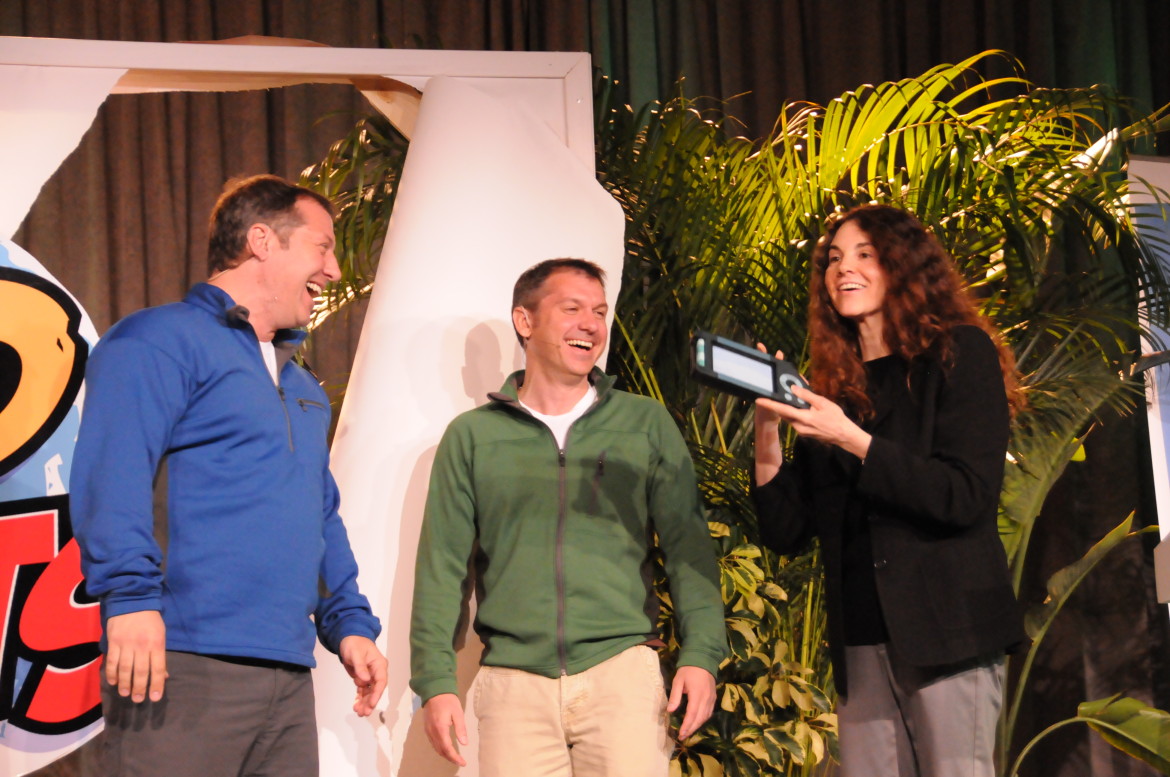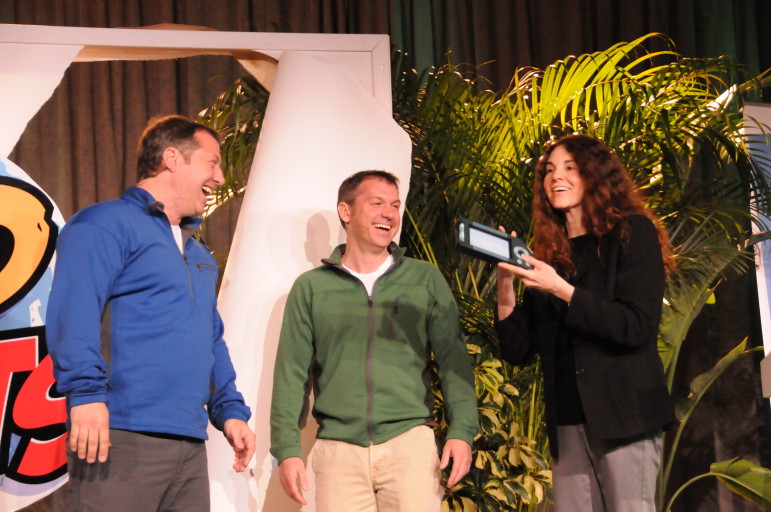Linda Simensky, PBS’s head of children’s programming, on carrying forward Mister Rogers’ legacy

Martin, left, and Chris Kratt, hosts of Wild Kratts, join Simensky on stage during the 2010 PBS Annual Meeting. Their series is one of several in a new generation of PBS Kids shows for preschoolers.

Martin, left, and Chris Kratt, hosts of Wild Kratts, join Simensky on stage during the 2010 PBS Annual Meeting. Their series is one of several in a new generation of PBS Kids shows for preschoolers. (Photo: PBS)
As a new father, our podcast host Adam Ragusea found himself worrying about how his 4-month-old son Freddie would grow up in a world where Mister Rogers’ Neighborhood isn’t on TV. He took his questions about how children’s television has changed since his own youth to Linda Simensky, v.p. of children’s programming at PBS. Their conversation first appeared on The Pub, our weekly podcast. This is an edited transcript.
Current: Given the state of children’s TV, do you think Fred Rogers could have started the same show as Mister Rogers’ Neighborhood today?
Simensky: In kids’ TV of the late 1960s, producers of Mister Rogers’ Neighborhood and Sesame Street were probably the only people who thought about creating programs for kids under the age of 5 or 6. The Nielsen demo for children was kids aged 2 to 11. Later Nielsen had the ability to break the demo into ages 2 to 5, which was preschool, and 6 to 11, older kids. Now you can break it into any combination of ages.
But for a long time, most of kids’ TV really only focused on kids between the ages of 5 and 8. And you had Fred thinking about kids probably as young as 2.
This was really the first time that anybody paid any attention to preschoolers. They really weren’t seen as a very interesting demographic. But Fred really made his name by thinking about younger kids.
When I got to Nickelodeon, in the mid-1980s, Nielsen was still measuring the audience as kids 2 to 11. And if producers were making a show for kids between the ages of 2 and 11, I can assure you that they weren’t thinking a lot about the 2-year-olds. The most they would think about is, “Okay. We’re not going to put on anything that makes 2-year-olds cry.”
As far as the state of kids’ TV today, there are so many more options now; it’s changed the way people think about the audience. Producers and programmers think about specializing in different age groups. Even in the time that I’ve worked in kids’ TV, that’s one of the biggest changes that I can point to.
At PBS we’re thinking about kids between the ages of 2 and 8. Cable channels run that age and slightly older; they’re thinking about kids 6-plus.
As far as curriculum, Fred probably wasn’t asked by the network to come up with a curriculum document. He was doing research on kids, and if he’d had to design a curriculum, I would imagine he was just making a show based on what he felt kids needed.
Now, at that point in time, did kids need “self-regulation,” which is a term people use today? I don’t know that researchers had figured that out by then, and I doubt that he would’ve been thinking about it in that way.
Fred would have thought that kids need to feel appreciated; they need to feel loved for being themselves, and they need to feel safe. That was really the foundation of what Fred Rogers was thinking about. At least, how I’ve interpreted it.
Current: But when educational television show producers talk about curricula, what exactly do they mean by that? What is the curriculum? Who dictates it? Does it have to be simpatico with educational curricula at the state or federal level? Or am I overthinking this?
Simensky: I came to PBS as a kids’ TV person, not an educational TV person, and learned that there’s actually a lot more freedom than you would suspect.
Each show finds its own curriculum advisors, and they figure out what is important. Part of the experience of pitching a kids’ show to PBS is to sit down with me and staff in my department and say, “We have a show about this particular topic, and it’s important for kids because of the following reasons.”
They basically have to convince you that what they want to do with their show is indeed important for kids. Sometimes they do.
Shows are being made today from a much better understanding of how kids learn — even as compared to what was done 10 years ago. There’s more understanding of what’s age-appropriate.
A huge part of creating a curriculum is figuring out what audience you’re targeting and what they’re capable of understanding about a particular topic. You have to balance it, obviously, with entertaining characters and great stories. And you really have to work the curriculum into what the characters are interested in and into the story.
If we’ve done our job correctly, you’ll find these shows are interesting and fun to watch. They don’t interrupt the story to teach the curriculum; it’s all presented in a seamless way. And yet the kids still do know that they’re learning.
Sometimes people will say to me, “Kids will be having so much fun watching this they won’t even know they’re learning.” But I want kids to know that they’re learning. A lot of kids want to be smarter than their parents and to impress them with something. I want PBS Kids to be the place that gives kids that tool. I don’t want to hide the education. In fact, if people use the word “edutainment” around me, it makes me want to scream. Because I feel like it’s so fake.
Our audience of kids 2 to 8 are all still in that age range where they do want to learn. They want to know things and to understand things that don’t make sense to them. I’ve tried to find shows that give them information they’ve been wishing for, or explain things a little bit.
We work with advisors to figure out what kids need to know, how to teach it to them and how to talk to our producers about it so that it sounds interesting.
Current: Much of what sustains the public TV economy is grant funding, whether it’s government, quasi-government or foundation grants. I imagine the grant-makers have rather specific demands about the curricula of children’s television. Is that difficult to negotiate?
Simensky: It varies. Sometimes people have goals that don’t really fit with what we’re trying to do. Usually that’s the end of that.
But if they do share our goals, then it can be a good fit. Right now foundations are particularly interested in learning that is social-emotional learning, such as character. That is a pretty good fit for us, and something we would look into.
I haven’t had to bend a show to fit a grant yet.
Current: Do you have to think about alignment with Common Core standards?
Simensky: There are people at PBS who do that. I’m thinking more about preschoolers, and I don’t think as much about school.
Sometimes clips of our shows can be used in schools to teach particular principles. So, in that sense, some of what we’re doing overlaps with what Common Core is asking for.
Current: As somebody who worked in commercial children’s television for years and now handles it at PBS, how do you assess the distinction between commercial children’s television and public children’s television these days?
Simensky: There is a huge difference. Here at PBS we spend a lot more time thinking about the audience and what the audience is capable of understanding, even if it’s just a joke.
When I’ve worked in other jobs, we asked, “Is this show funny?” and “Will kids love this show?” But there wasn’t a lot of discussion or thinking about who these kids were.
I haven’t worked in commercial TV in 11 years now, so it may have changed. But I never really thought a lot about the audience, its age range or needs.
At PBS, really, that’s a lot of what we think about, including the things we could do to improve their lives. It is as mission-driven and as sincere as you suspect it might be, and that actually makes our work easier in a lot of ways.
I was pretty hardcore as a commercial TV person. Really, the only thing I cared about was, “Is this show funny?” Then I had kids, and my opinion changed about what people who made shows for kids should be thinking about. I got much more interested in, “What is it like to make the right show for kids? What would kids find interesting?”
Current: In any business oriented towards kids, there’s a tension between marketing and trying to appeal directly to the kids versus trying to appeal to their parents, who will then expose their kids to whatever it is. And in educational public television that could influence the extent to which PBS pushes legacy brands, such as Sesame Street, that trade on the emotional investments that generations of people have with public television versus newer shows that are really made for kids in the year 2015.
Simensky: For kids between the ages of roughly 2 and 4, it’s really their parents who decide which shows they watch. And today’s parents of young kids grew up on a lot of the things that are popular now. For example, adults who grew up on Nickelodeon are now parents.
There is a certain amount of nostalgia that parents bring to choosing what their kids watch, and it really does shape people’s opinions. When people reach a certain age and become parents, they want to share things from their childhood with their kids. The kids can react differently than the parents want them to react, too.
And shows like Sesame Street that have that nostalgia going for them aren’t the same as the Sesame Street that today’s parents grew up with. It’s very much a new Sesame Street.
New parents are looking for some level of comfort and understanding. Navigating the kids’ universe is a little scary. And there is a certain amount of comfort in going to PBS, because you know that our shows have to be educational. They have to be good for kids.
Eventually parents start to experiment. They get a little more comfortable and check around to see what else is out there. Are there other good shows? By the time your kids are about 4, you’re just happy for anything that keeps them quiet.
I hate to say that, because it sounds like you’re using TV as the babysitter. But there are parents who want to make dinner or do laundry. They want to put their kids down for a few minutes, and sometimes they put them down in front of something like a TV.
Current: The entire public media system, TV and radio, has so much invested in certain legacy public television brands. When CPB’s funding is threatened, lobbyists bring Big Bird to Capitol Hill to make the case for saving it. In a way, the whole enterprise rests on that nostalgia that you talked about. Do you sometimes feel hampered by that? Like you need to progress?
Simensky: We make a lot of new shows, so I feel that we have progressed.
Here’s the reason why people depend on kids shows to make the case to Congress: Most grownups don’t watch kids’ TV, but they remember Sesame Street and Mister Rogers. They can talk about them fluently. If I meet a person who doesn’t have small kids in their life but watches Peg + Cat a lot, I’d be very surprised and possibly a little confused. I don’t expect people in the general audience to watch all of these shows and be fluent in them. But that makes it harder for us to talk about our new shows, because they’re not as familiar with them. They don’t have kids watching them at home.
And so, it’s not that people don’t care or that PBS hasn’t continued to make new shows, because we certainly have.
Since you have a young son, you’ll see that the shows that he likes; if he watches PBS, it might be Daniel Tiger’s Neighborhood, Curious George, Wild Kratts, Peg + Cat and Super Why!
But you’re not going to be able to walk into a crowd of government people in their 50s and 60s and say, “Hey, did you catch that episode of Peg + Cat last week?” They won’t have seen it. And it’s almost unfair to expect them to be fluent in it. They do know Sesame Street, because it’s been around for a while.
In about 20 years, there will be people who will quote Arthur pretty fluently. Because they watched it as kids, their kids watched it and they will have grandchildren who are watching it.
But if lawmakers have to use nostalgia to make their case for funding, it shows that when PBS is given the right tools to do things, that we can make programs that have that much impact.
Current: I have that impulse to share the shows I remember with nostalgia. When my son Freddy gets a little bit older, I want him to watch Mister Rogers. What’s the Mister Rogers of today?
Simensky: The show that is teaching all of the Mister Rogers lessons is Daniel Tiger’s Neighborhood, which is made by the Fred Rogers Company. That team is literally saying, “What would Fred do?” as they develop shows. They have this term, “Fred-ish.” If some idea doesn’t seem like something Fred would’ve done or said, they’ll decide, “That’s not Fred-ish enough.”
I’m not kidding. That’s how they speak, because they are making the show to continue on with Fred Rogers’ teachings and his research.
This is why we felt we could replace Mister Rogers when Daniel Tiger was ready. It is teaching the same things. It’s got the same advisers, including Hedda Sharapan, who worked with Fred. She is working on Daniel with all the people who are very eager to keep Fred’s vision going.
But you’re also asking the question, “Who is the adult male figure that is replacing Fred today?” And there is none. I’d say the closest anybody ever got to that was probably Steve on Blue’s Clues. And I can tell you that finding an adult male TV host for preschool is not the same as it was back in the early ’60s. There’s not another Fred waiting in the wings. We’ve had a lot of people come in and say, “I am the next Fred Rogers.” But they aren’t.
I like to quote my colleague Paul Siefken, who used to work with me at PBS and now he is helping to run the Fred Rogers Company. Typically, it’s been men who come to us and say, “I am the next Fred Rogers.” After those meetings, Paul would always ask, “Would anybody let this guy babysit for their kids?” He’d also ask, “What is their motivation for doing a show for preschoolers?”
If he wasn’t pleased with the answers to those two questions, he would say, “We absolutely cannot work with this guy.” He never felt like he got the right answers. He never saw any adult male that seemed right for a preschool show.
It’s the kind of people who come in and say “I’m the next Mister Rogers” who aren’t. Their motivation for doing a show is not the same as Fred’s. Usually, they want to be famous as a show host, which is not the right motivating factor to host a preschool show.
Current: We’ve established that there’s a market vacuum that someone could fill. I can’t overemphasize how important having a nurturing, kind and gentle adult male role model was to me and people in my age cohort. It helped boys acquire some more progressive concepts of gender. Those concepts have been very useful to me. And they contrasted so much with other male role models of the time, like Hulk Hogan.
Simensky: Right. There aren’t many adult males on TV today. Typically they are sitcom dads and not exactly role models for anything.
Adults are often used ironically in TV today. And preschool kids don’t understand irony. It’s a concept that kids under the age of six don’t understand, like sarcasm. They’re very literal, and they trust what you’re telling them.
There are some shows out there that have young male hosts, but few people really fit the model that would work for us. But I can tell you, when people come in and they say they’re the next Mister Rogers, they never are the next Mister Rogers, as far as I’m concerned.
Related stories from Current:






This interview demonstrates why Linda Simensky is always the smartest person in the room
Very interesting. I recommend math with peg + cat. #ProblemSolved